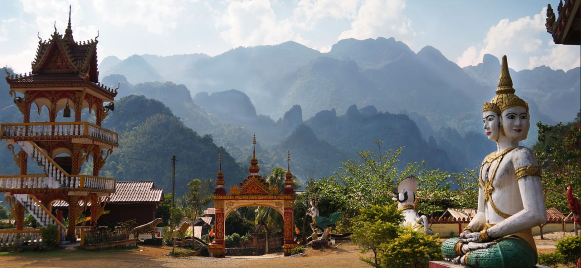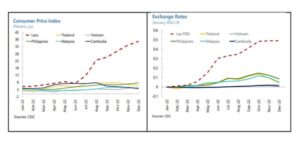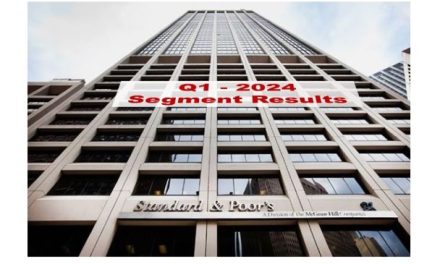Laos has long been considered one of the most idyllic countries in Southeast Asia, a symbol of a bygone, more relaxed age. That image was always a distortion of the difficult lives led by so many Laotians. But today, conditions in the country have become ever more challenging but there are signs of hope as the economy starts to recover writes Adrian Ashurst, CEO of Worldbox Intelligence.
 Laos has long been considered a laid-back paradise. Norman Lewis, considered by some to be the finest travel writer, visited the country back in 1950 as the war against the French ripped through Indochina. Yet he still found “the earthly paradise that all the French had promised; the country that was one vast Tahiti, causing all the French who had been stationed there to affect ever after a vaguely dissolute manner”.[1]
Laos has long been considered a laid-back paradise. Norman Lewis, considered by some to be the finest travel writer, visited the country back in 1950 as the war against the French ripped through Indochina. Yet he still found “the earthly paradise that all the French had promised; the country that was one vast Tahiti, causing all the French who had been stationed there to affect ever after a vaguely dissolute manner”.[1]
The Laotians’ relaxed approach to life remained apparent even after 25 years of war, as The New York Times writer James W Markham noted in a 1974 despatch:
“‘The Vietnamese grow rice. The Khmer watch rice growing. The Lao listen to rice growing.’” Somewhere in this jolly colonial slander, fashioned by some anonymous French wit, lies a grain of truth that helps explain why the Kingdom of Laos is at peace while its Indochinese neighbors, Vietnam and Cambodia, remain at war. To their eternal credit, the warring Lao parties—the American‐funded Vientiane Government and the North Vietnamese‐nourished Pathet Lao—never were very warlike: Their instinct on the battlefield was for compromise, not carnage. It was not unknown for Lao commanders to meet, compare their respective forces and declare the preponderant side the winner.”[2]
Pandemic ravages economy and living standards
Sadly, however, Laos’ image as a slice of heaven on earth has taken a battering in recent years. The economy has been hit hard by an unfortunate and deadly combination of circumstances, exacerbated by the Covid-19 pandemic. The economy had grown by nearly 8% a year over the decade leading up to the Covid pandemic, placing it among the fastest growing economies in the world. The government’s commitment to WTO accession and the creation of the ASEAN Economic Community (AEC) in 2015 led to major reforms of economic policies and regulations aimed at improving the business and investment environment. The exploitation of natural resources, in particular the development of hydropower, driven by massive foreign investment, powered the economy.
However, Laos’ small and open economy was among the worst hit in the world by the pandemic. The Ukraine war caused commodities to spike with Laos particularly hard hit by rising fuel prices. The consequent growing trade imbalance precipitated a sharp fall in the value of the kip against the dollar, further fuelling inflation, which peaked at 41% in February 2023. The price of food and fuel spiked even higher, causing severe hardship to many. Meanwhile, a sharp increase in agricultural input costs and transport disruptions also depressed economic activity in Laos’ agricultural and manufacturing sectors. By the end of 2022, 64% of Lao families were living on the same or a lower budget than a year earlier, according to the Lao Economic Monitor, published by the World Bank. [3]
Figure 1: Inflation surge and kip depreciation highlights Laos’ woes
However, signs of hope for Laos are finally emerging. The IMF concluded an Article IV consultation with the country in May by saying that:
“The prospect is for a return to steady growth in 2023, supported by higher regional growth, particularly through tourism, exports of goods, and resource extraction. Falling global commodity prices would allow inflation to gradually fall.” [4]
Meanwhile the Lao Economic Monitor forecasts that growth will accelerate 3.9% in 2023 from 2.7% in 2022 – in the medium term, led by a continued recovery in services and exports.
Travellers return
Increasing tourism revenues also provide ground for optimism. Laos registered around 1.3 million tourists in 2022, above the government’s target of 900,000. The government hopes to attract 1.4 million visitors in 2023, including an estimated 368,000 visitors from China, which opened its borders with Laos in January after abandoning its severe “zero COVID” policy. That target looks like being exceed by a considerable degree. The country had already welcomed more than 1.1 million foreign visitors in the first four months of 2023, more than double the number that visited Laos in the same period of 2022.
The new high-speed rail link with China, which opened in 2021 is likely to prove a boon for tourism. The authorities estimate that around 368,000 Chinese travellers will visit Laos in 2023, up 21% from last year.
Oil on troubled waters
The recent period has also proved politically turbulent – by Laotian standards. Prime Minister Phankham Viphavanh, who assumed office in March 2021, resigned in early January 2023 and was replaced by Sonexay Siphandone. It sems likely that Phankham paid the price for the economic woes that have beset the country in recent years, and that have prompted popular unrest in the forms of social media criticism and one-off street protests.
That at least is the view of the Council on Foreign Relations (CFR), an American think tank specializing in U.S. foreign policy and international relations. In April, Joshua Kurlantzick, a senior fellow for Southeast Asia at the CFR, wrote that the new prime minister, Sonexay Siphandone, “appears willing to implement several measures that, if they are effective, might cool public anger.” [5]
Kurlantzick added that “despite his origins as a princeling—he is the son of former President Khamtay Siphandone—Sonexay proposed an agenda should find support among ordinary Laotians, including a poverty reduction program, a bailout from the Asian Development Bank and a renegotiation of the country’s debt”.
Kurlantzick also said these “commonsense proposals” should help to stabilize the economy and restore growth. He added that that Sonexay may have more credibility than his predecessor, given his pedigreed background. That “might make him better positioned to push through the tough but necessary choices needed to get the economy back on track”.
One has to hope that the government’s reform efforts to bear fruit. Because, as Kurlantzick points out there is a danger of larger, more widespread protests if they don’t.
5 https://www.cfr.org/article/unprecedented-protests-are-putting-laos-uncharted-waters
About Worldbox Business Intelligence
Worldbox Business Intelligence, headquartered in Switzerland, is a Global API data solution provider of business intelligence and used in data analytics.
With the Global API solution Worldbox Business Intelligence enables clients and partners also a frictionless real time onboarding, KYC and compliance verification while rapid global investigations are provided, if needed.
Worldbox Business Intelligence provides global data in a standardised structure to more than 200 Million companies worldwide. The global network of subsidiaries, branches and desks allows to precisely and efficiently collect data and target key territories for clients and partners.”
“Worldbox Business Intelligence – Bringing Swiss Precision To Data“
Copyright (C) 2023 Worldbox Business Intelligence. All rights reserved.
[1] The Dragon Apparent, Norman Lewis, 1951
[2] https://www.nytimes.com/1974/08/25/archives/the-ho-chi-minh-trail-is-a-highwaynow-letter-from-laos.html
[3] https://www.worldbank.org/en/country/lao/publication/lao-economic-monitor-may-2023-addressing-economic-uncertainty-key-findings
[4] https://www.miragenews.com/imf-wraps-up-laos-article-iv-consultation-1011493/
[5] https://www.cfr.org/article/unprecedented-protests-are-putting-laos-uncharted-waters
Our mailing address is:
Worldbox Business Intelligence
Breitackerstrasse 1
Zollikon
Zurich 8702
Switzerland




























